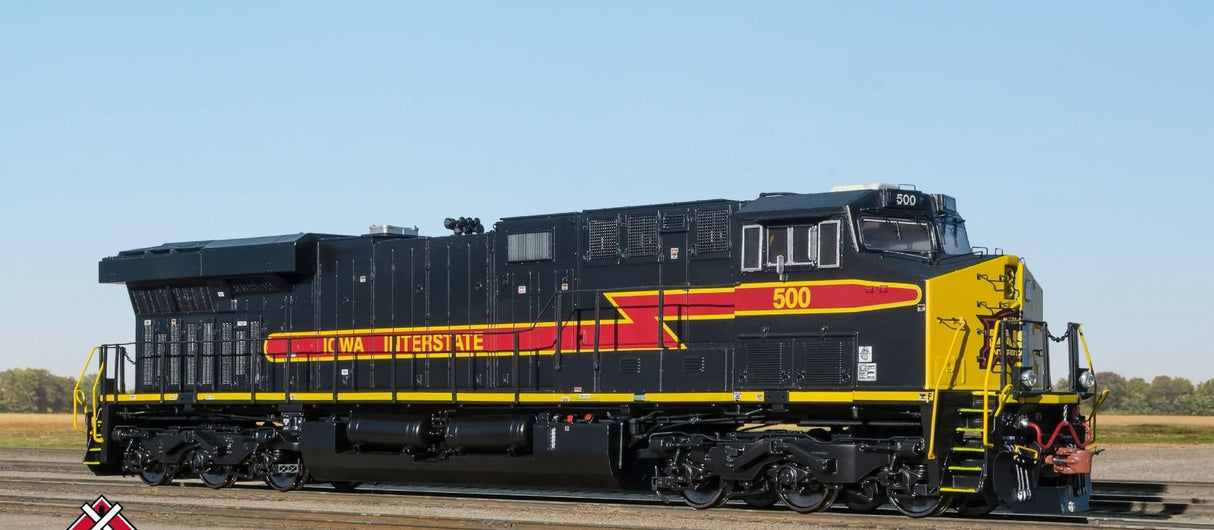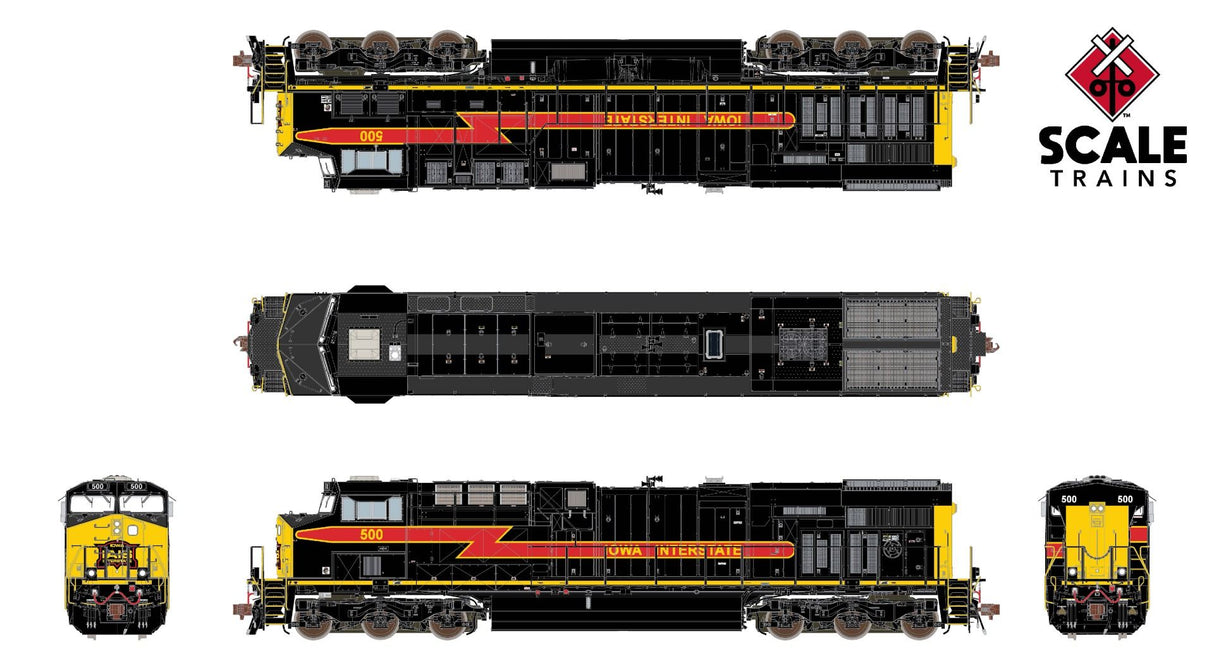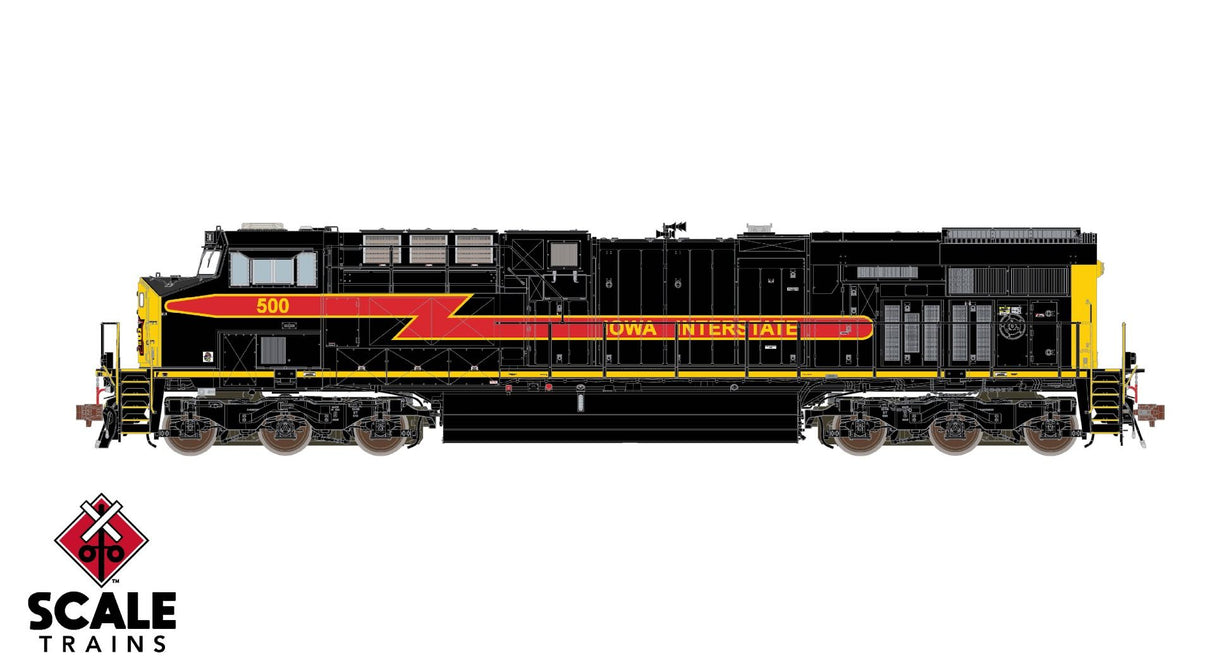ScaleTrains SXT33598 GE ES44AC, Iowa Interstate/Early Antenna Arrangement #500 DCC & Sound HO Scale
ScaleTrains SXT33598 GE ES44AC, Iowa Interstate/Early Antenna Arrangement #500 DCC & Sound HO Scale is backordered and will ship as soon as it is back in stock.
Couldn't load pickup availability
Description
Description
ScaleTrains Rivet Counter SXT33598 GE ES44AC, Iowa Interstate/Early Antenna Arrangement #500 DCC & Sound HO Scale (Note pictures may show a different road number).
In 2002, GE introduced the “Evolution Series” of locomotives. Better known as GEVo or ES44, this series has become the best-selling line of diesel locomotives of all time with production nearing 8,000 units.
Our Rivet Counter series model renders the numerous variations of cabs, dynamic brakes, doors, grilles, trucks, etc. We’ve also incorporated LED lighting effects including front, rear, and side walkway lights; ground lights; printed and lighted number boards; and ditch lights.
Road Number Specific ScaleTrains
- Era: July 2008 to present
- IAIS Series 500 to 511, built 7/2008
- Road numbers 500, 502, 506 and 511
- ‘As Delivered’ or early Antenna Arrangement
- Cab roof large square antenna dome and wireless matrix round dome antenna with conduit
- No rear ditchlights
- Fully-assembled
- Multiple road numbers
- Operating LED ground lights on both sides of locomotive*
- Operating LED front, rear and rectangle side walkway lights*
- Operating LED front and rear deck-mounted ditch lights**
- Printed and LED lighted number boards*
- Semi-scale coupler buffers equipped with die-cast metal semi-scale SBE bottom shelf knuckle couplers
- Single trainline hose with silver gladhand
- Front dummy Multiple Unit (MU) receptacles mounted to front anticlimber supports
- Front and rear raised pilot-mounted Multiple Unit (MU) receptacles
- See-through round-hole stepwell steps
- Walkway with front anticlimber and support brackets
- GE “nub” pattern walkway tread
- Early handrails with wrap over stanchion heads left long rail for walkway box clearance and right long rail with bolted head on 2nd lower stanchion
- Wide profile end handrails
- Sand box clean out door with knuckle buster latch
- Front nose headlight
- Front straight grab irons mounted directly to the nose
- Front left side mounted narrow nose drop grab iron
- Left nose door with window
- Front high-mounted (cab) numberboard housings
- Dual cab side blue flag holder
- Left side under cab front access bolted panel; rear door with square corrugated grille
- Early cab with optional 4 side windows; without barrel bolt latches on subbase doors
- Detailed cab interior with separate floor, rear wall, seats, and control stand
- No grade crossing camera
- Tinted cab side windows
- Tall mirror mounted in front of sliding cab side windows on both sides; additional small mirror on right side
- Small bolted and hinged inverter cabinet door
- See-through dynamic brake exhaust
- Left side dynamic brake cab: tri blower dynamic brake with flush exhaust
- Etched metal see-through dynamic brake intake grilles with blower motors visible inside
- Right side dynamic brake cab: door with grille, small grille, door with grille, and door with grille
- Dynamic brake cab door with low door handle and low mounted door handle bumper
- Short right side air intake grille
- Left side auxiliary cab: 3 medium doors with latches on #2 door and short auxiliary cab filter box door
- Right side auxiliary cab: 4 doors with latches on #1 and #4 doors
- ES44 style engine cab doors: latched first door in each set of three
- Two engine cab roof lift rings
- Lost wax brass cast Nathan AirChime K5HLR2 horn mounted on engine cab roof
- Separate exhaust stack
- Left side exhaust cab doors: latched last door in set of three
- Flush heat exchanger housing with two piece wide slot grille
- Flush radiator grille
- 22 individually applied etched metal see-through radiator intake and exhaust grilles on sides and top of radiator compartment
- Left side radiator cab grille arrangement: Raised doors. Grilles – tall-short-tall-tall-tall, short front angled grill, two-piece rear angled grille, no grille under brake wheel
- Right side radiator cab grille arrangement: Raised doors. Grilles – tall, short, tall, tall, tall, tall, short, tall, short front angled grill, two-piece rear angled grille
- Angled water fill box
- High mounted horizontal rear headlight
- Rear wide-spaced dual dummy Multiple Unit (MU) receptacles
- Accurately profiled frame with separately applied plumbing and cabling
- Early GE Steerable trucks with separately applied brake cylinders, air plumbing, and rotating bearing caps
- Triangular handbrake chain bracket
- Toilet drain with exterior handle
- AEI tag mounted to right sidesill
- Dual Graham-White (Salem) accordion 824 air filters
- Graham-White 994-500 air dryer
- 5,300-gallon fuel tank with internal waste retention tank, digital fuel gauge, vertical fuel gauge, and round fuel gauge
- Dual fuel fills per side with rear fill “blanked”
- Angled top left side fuel tank top box
- Long crankcase drainpipe attached to the end of the fuel tank
- Factory-applied wire grab irons, snowplow with grab irons, spare knuckles, trainline hoses with silver gladhands, 3-hose MU clusters with silver gladhands, uncoupling levers, windshield wipers, mirrors, sunshades, air tanks, fuel tank mounted electronic bell, brake wheel, and more
- Motor with 5-pole skew wound armature
- Dual flywheels
- All-wheel drive
- All-wheel electrical pick-up
- Directional LED headlights
- Printing and lettering legible under magnification
- Operates on Code 70, 83, and 100 rail
- Packaging safely stores model
- Minimum Radius: 18”
- Recommended Radius: 22”
DCC & sound equipped locomotives also feature:
- ESU-LokSound 5 DCC and Sound decoder with “Full Throttle”
- Two (2) cube-type speakers
- Accurate GEVO-12 prime mover and auxiliary sounds, horn, bell, and more
- ESU-designed PowerPack with two (2) super capacitors***
- Operates on both DC and DCC layouts
* Lighting features operate when using an ESU decoder with appropriate programming while operating using DCC
** During DC operation, class lights illuminate in white. Access to other colors and the ability to change colors requires an ESU DCC decoder while operating in DCC
*** Compatible with appropriately programmed ESU decoders while operating using DCC
In 2002, GE released the first GEVo, a new series of locomotives that would replace the AC4400CW and Dash 9-44CW. The first two models were the ES44DC and ES44AC. The ES44C4 followed a few years later.
The new models were designed to meet the stricter diesel locomotive emissions standards imposed by Environmental Protection Agency (EPA) regulations. The EPA “Tier” emissions standards are a series, or Tiers, of allowable emissions levels based upon a locomotive’s date of manufacture. In 2005, Tier 2 took effect followed by Tier 3 in 2010 and Tier 4 took in 2015.
GE developed a new diesel engine, the 12-cylinder GEVO 12, to meet the new emission standards. Both the bore and stroke were increased to produce the same 4,400 horsepower as the older 7FDL16 16-cylinder engine.
The new prime mover drives an alternator producing AC current that is rectified to DC current. On the ES44DC, this powers the traction motors. On the ES44AC and ES44C4, the DC current is “chopped” back into AC to power the traction motors. The two models share a common 73’ 2” frame and external appearance.
The external appearance is similar to the AC4400CW. In fact, the cab on early ES44s is almost identical. In 2009, GE changed the cab and nose, moving the nose door from the left side to the right side and replacing the curve seams with more square seams.
Unlike their predecessors, both the AC and DC versions of the ES44 have the large box behind the cab. The biggest visual difference is the larger “wing” structure over the radiator cab. The thicker radiators and related equipment in the radiator cab work to cool the exhaust, which reduces emissions.
Customer options and design changes have resulted in seven different dynamic brake configurations. The grilles on the sides of the radiator cab have also gone through seven configurations. The most recent units have changed the latches on the engine cab doors to match the ET44 units.
Although EPA Tier 4 standards went into effect in 2015, the ES44-series continue to be built. This is due to the Tier 4 Credits, a complicated system that allows GE to continue to build and various railroads to buy the ES44 based on the number of Tier 4 units built.
After 2 testbed units and 35 pre-production units, over 7,600 additional ES44s have been built. All of the major railroads including BNSF, Canadian National, Canadian Pacific, CSX, Norfolk Southern, and Union Pacific have fleets with 100s of units. Florida East Coast, Ferromex, Iowa Interstate, and Kansas City Southern also operate ES44s. In addition, 131 were built as lease units for Citirail.
The ES44 has become the best-selling diesel locomotive of all time.
Iowa Interstate (reporting mark: IAIS) is a Class II Regional Railroad that operates in the states of Illinois, Iowa, and Nebraska. The railroad began operations in 1984 on 580 miles of former Rock Island track. Grain products are the primary commodity shipped on the IAIS but the railroad is also known for hauling coal, frac sand, metals, ethanol, and intermodal traffic. In 1985, the railroad was able to access Chicago via trackage rights over CSX and Metra rails.
In the early years, IAIS rostered a mixture of ancient ALCOs and rebuilt first-generation EMD locomotives. As the company became more profitable and restructured, they refined their locomotive roster by replacing older units with reliable GP and SD38 series models. In the late 2000s, however, they turned to GE by ordering a series of 14 ES44 GEVO locomotives. These units were built to CSX specifications with early radial or “steerable” trucks. The majority of these units were painted in the company’s stunning black, yellow, and red livery with large IAIS logos on the GE safety cab.
The first locomotives in the series arrived on the property in November of 2008. Upon delivery, Iowa Interstate added rear ditch lights since there aren’t many places to turn locomotives on its system. After ditch lights were installed, the GEVOs were placed into revenue freight service. They quickly became fan favorites and were joined by the rest of the series as individual units were delivered over the next year. In December of 2009, road number 513 was painted in a special Rock Island “Rocket” heritage paint scheme at Mid-America Car, Inc. near Kansas City, Missouri. It was delivered to Iowa Interstate in January of 2010.
In 2014, IAIS purchased three (3) additional “Tier 4 Credit” ES44 GEVOs that were built in Fort Worth, Texas by GE Transportation successor, Wabtec. Visually, they are identical to the original order from 2008, aside from road number 516, which was painted in a special red and yellow 30th Anniversary paint scheme. All of Iowa Interstate’s ES44 GEVOs are similar to Norfolk Southern’s units in that they have both front and rear flashing ditch lights. With limited turning facilities along their mainline, the rear ditch lights allow IAIS trains to operate at track speed.
Specifications
Specifications
-
Scale-
-
Product Type-
-
Height
-
Width
-
Depth






